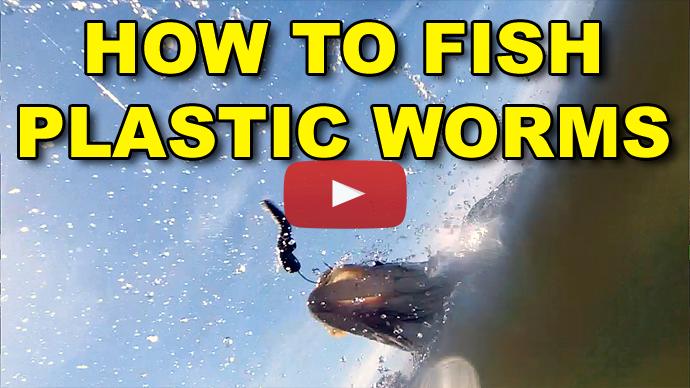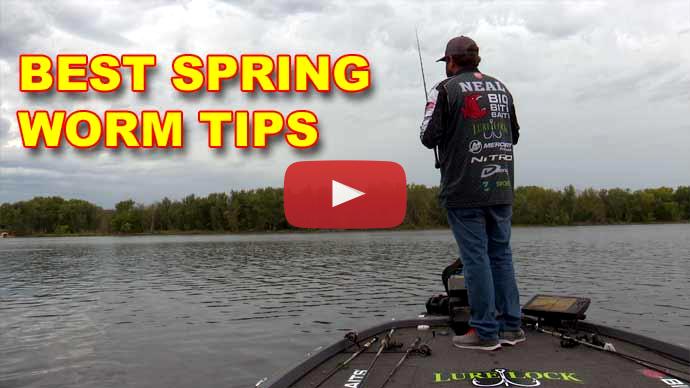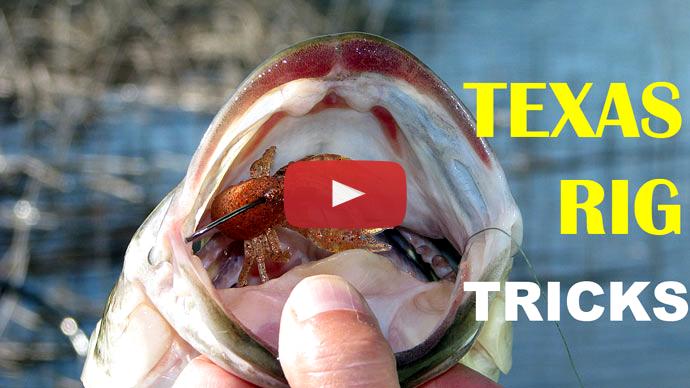So I bet you're watching this video because you know worms can be really good, plastic worms can be really good fishing in the spring, but you know, what are the different ways to fish it? Especially, you know, spring is changing all the time. You got pre-spawn, spawn, post-spawn. What are the best ways to fish it? And where should I fish it? So that's what I wanna talk about today, is help you catch more fish on plastic worms during the spring. So, let's talk first of all about kind of what I'm doing here. First of all, I'll use a 7-foot, 7-foot-2 medium power fast action rod. And that is just like the jack-of-all-trades kind of rod. You can use that for a variety of things but it's really good for worm fishing.
So that's what I use, and I'll pair that with a reel that's in the low 6 range, like 6.3:1, 6.2:1, somewhere in there. You don't need a real fast speed reel for this technique. So, you know, don't run out and buy a reel if you don't have that and you got a higher speed reel, just remember you gotta slow down. But, you know, if you got a reel in that gear range, perfect, perfectly suited for that. And I'll use a 15-pound Seaguar InvizX Fluorocarbon line, no leader, just straight up all fluorocarbon. That is all-purpose, you can fish that in just about any type of cover you can imagine. Braid, not so much. Braid tends to dig into wood and tends to get frayed in rocks, whereas fluorocarbon doesn't do that. So, I like to use fluorocarbon for just straight-up fluorocarbon for my worm fishing.
Now, with a worm, it's a nice slender, you know, piece of plastic. There aren't any appendages on it. It's not bulky, so it goes through the water real easy. So, I don't put heavy weights on it, especially in the pre-spawn. A quarter-ounce is about as heavy as I'll go. If you use like a three-eighth or anything more than that, they'll just, boom, they'll shoot right through the water column really fast. And you wanna slow fall during the springtime in order to entice a bite. The slower it falls, the longer it's in the strike zone, the more apt it is to get bit. So an eighth-ounce to quarter-ounce weight is what you want to use. And I use tungsten weights for better feel and sensitivity. So that's how I rig it up. I put a three Gamakatsu Extra Wide Gap hook on there, just your standard normal wire, not a flipping hook and you're good to go.
Now, how do we fish it? Well, let's start off with the pre-spawn. In the pre-spawn, it's a little bit cold. Water temps have just breached into the 50-degree range, so it's low 50s up until about the mid-50, little bit above upper 50s. That's what I consider pre-spawn. So, that time of year, the fish are a little bit slower. They're not quite as aggressive until the water gets up to about the mid-50s. Then they start picking up. But typically when that water temperature is in that upper 40s, low 50s, what I'll do is I'll use that eighth-ounce weight and I'll fish it a little bit deeper. What I mean by deeper is typically in the summer you're fishing real shallow. So deeper might be 15 to 20-foot deep and you'll focus on areas that are, you know, areas of structure. I like fishing points myself, I just find points on a lake and I go for that. And I aim for about 10 to 15 feet and I start working my way out until I connect with a fish. And how I fish it is real slow. Here you just, there's really three ways to fish it, and the first one's just dragging it on the bottom. Throw it on out there, let it fall. And as it's falling, by the way, watch your line because sometimes a fish will hit it as it's falling and you won't feel it because you want it on slack line. Don't throw it out and cock your reel and let it, you know, wait, let pendulum down. It's not gonna stay in the strike zone. So throw it out and give it some line, pull some line outta the reel and just let it fall straight down on slack line.
So you have to watch that line very carefully. And if a fish bites it, you might see the line, just do a little twitch or it might peel away, start disappearing quicker under the water. And when you reel up to it after it's hit the bottom, you might see your line swimming off to one side or the other. Well, you know, fish has got it, so set the hook. So you gotta pay reel close attention to where the line enters the water. Once it hits the bottom, the first thing I like to do when it's real cold is just drag that worm. Just slow and move it only few inches and pause. And the pause will be anywhere from 5 seconds to 30 seconds long. You gotta experiment with it. Sometimes the fish want longer pauses, sometimes they don't. And you just don't know from day to day. So you have to play with that a little bit. And when you get that bite, again, it's gonna be very subtle. Sometimes they just pick it up and don't move with it. So you have to be on point, pay attention, and any kind of change in weight, a little movement, a little twitch, something like that, set the hook. That's why I like to use that tungsten weight, I get a little more sensitivity to it.
Keri: Woohoo.
Glenn: Nice.
Keri: Putting on a clinic today.
Glenn: Yeah. So that's one way to fish it. A second way to fish it is again, using that fall. It's just that, let it fall, and once it hits the bottom and a fish hasn't picked it up, lift it back up and let it fall again on slack line and watch for that bite and let it sit. And the pauses in between those movements can be anywhere from 5 to 30 seconds. Again, really long when the water's cold, and just lift it up a few inches off the bottom, let flutter back down and let it pause for a while. And then the third way to do it is, I like to swim it a bit. So especially if I'm fishing for the shore, but I like to throw it out deep and just slowly reel it and let it swim just above the bottom and just work its way back up at a nice slow, slow crank. This is again, why you don't want a fast-speed reel. Just slowly crank and let it bounce along the bottom and maybe over the top of emergent weeds or submergent weeds. That works really well during the pre-spawn. Now when I get into a little bit later in the pre-spawn, you know, it's a little bit warming up, a little more active, then I'll speed up the cadence. So shorter pauses and I swim the worm at a faster speed. But that's essentially what I'm doing is just the same presentations only faster.
Now during the spawn, hey, the spawn is different. Fish are on the beds and they are usually locked on or very close to being locked on. What I mean by that is they're not gonna move very far off the bed, if at all. That approach requires a little bit more finesse because you can spook them if you bring your boat right up on them, or if you're on the shore and you walk up right up on them, they usually like to make a bed right there on the edge of the shoreline. And you can make, you can scare them. So, in this instance, I'm using a weightless worm, just take the weight off of it because I want that to land softly on the water and then slowly come down, just use the weight of the hook for it to slowly fall very enticingly. So here what I do is I'm using a spinning rod now, it's still a 7-foot-2, medium powers, fast action rod. Here I'll use 10-pound InvizX line and, of course, the spinning reel. But the premise is, is you cast over the bed past it, 3 or 4 feet past it, let it splash down, and then slowly kind of pull on the line, and as it falls, you know, slowly kind of swim towards that bed. And when it lands, it's not gonna make a big thud or a lot of commotion to spook that fish, so it's very natural.
Typically, while it's falling, that fish will turn around and look at it and they might hit it right then, you'll see it. So, beware, you see the fish bite, don't necessarily set the hook right away, wait till you feel them, because sometimes they'll hit it and you set the hook and there's nothing there. That's because they haven't grabbed it yet, they've just hit it. They'll do that sometimes when they're on bed. So make sure the fish has it before you set the hook. But that's how I typically fish beds, and I'll make long casts, get away from the bed, you know, 10, 15, maybe 20 feet away, sometimes further and make long cast to them so you don't spook the fish using that spinning gear. You can do that and just get it past that bed and slowly work it over the bed and you'll get bit that way.
Good fish. I'll take it on a worm. Plastic worms, man, they've been around for decades and don't get old. This fish still fall for them. Now during the post-spawn, I go back to the weighted Texas rig plastic worm, but here I'll kind of do away with the eighth-ounce and I'll stick with that quarter-ounce because I want a bit of a faster fall now. And I'll do the same retrieves except now I'm not doing the drag retrieve. I'll do the same retrieves that I did in the pre-spawn, except I'm not doing the dragging on the bottom retrieve. I replace that and instead, I like to swim it across the surface. Top water can be an amazing bite this time of year right after the spawn, throw it out there, reel up on it and just reel enough to keep it on the surface kind of swimming along like a snake. Now sometimes you might have to go to that eighth-ounce weight to keep it up on the surface, so you're not buzzing it, because sometimes that's what they want. Sometimes they want to be buzzed, but if you wanna slow it down, lighten up on the weight, that eighth-ounce or sometimes even weightless, you cast it out there, let it sit on the surface, and just reel it in just to swim it right back to you. That could be killer, that's a fun way to fish. I don't think a lot of people do that because, boy, I am really successful doing that.
So give that a try during the post-spawn, the rest of it, again, using a quarter-ounce weight, flipping, throwing it, you know, pitching it up to boat docks, the boat pilings, sunken brush piles, anything you can see visible on the shoreline, the cover, just flipping and pitching that worm into it and let it snake its way down through the cover. And a lot of times it gets bit before it even hits the bottom. So pay real close attention again for that bite. And make sure you don't miss a lot of bites and you're gonna have yourself a lot of fun during the post-spawn.
So, that's the main ways how I fish, fish in a worm during the springtime.
BassResource may receive a portion of revenues if you make a purchase using a link above.



